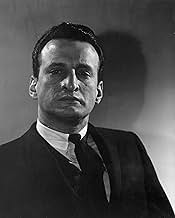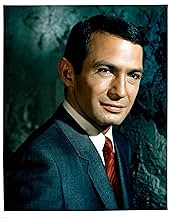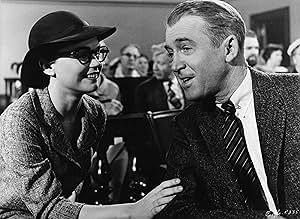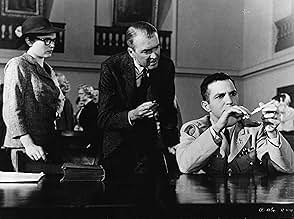In einem Mordprozess erklärt der Angeklagte, er sei nach der Vergewaltigung seiner Frau durch das Opfer vorübergehend unzurechnungsfähig gewesen. Was ist die Wahrheit? Und wird er den Prozes... Alles lesenIn einem Mordprozess erklärt der Angeklagte, er sei nach der Vergewaltigung seiner Frau durch das Opfer vorübergehend unzurechnungsfähig gewesen. Was ist die Wahrheit? Und wird er den Prozess gewinnen?In einem Mordprozess erklärt der Angeklagte, er sei nach der Vergewaltigung seiner Frau durch das Opfer vorübergehend unzurechnungsfähig gewesen. Was ist die Wahrheit? Und wird er den Prozess gewinnen?
- Regie
- Drehbuch
- Hauptbesetzung
- Für 7 Oscars nominiert
- 10 Gewinne & 18 Nominierungen insgesamt
Empfohlene Bewertungen
If you haven't yet seen Anatomy of a Murder, you've got to buy a copy and host a movie night as soon as you can. You're going to want to own your own copy, since this exciting courtroom drama can be enjoyed over and over again. I've lost track of how many times I've seen it, and it never gets old. I'm a huge fan of the boundary-pushing director Otto Preminger, and he once again pushed the envelope of the censors in 1959. In this movie, the words "rape" and "panties" are spoken several times - shocking at that time!
James Stewart, in his silver-haired charm, stars as a defense attorney with passions outside the courtroom. He loves fishing, he loves jazz music, and he loves the sight of a good-looking woman. When the latter appears in his office, in the form of Lee Remick, asking for his help in her husband's upcoming trial, he agrees to take the case. Lee is beautiful and sexy, and she brings out such a flirtatious spark in Jimmy. Her husband, Ben Gazarra, will be on trial for murdering the man who raped and beat her up. It seems like an easy case, right? Not exactly.
There's much more to the situation than meets the eye. As Jimmy explains to Ben on their first, memorable meeting: "There are four ways I can defend murder. . ." I love that scene. It's clever and concise without seeming glib or artificial. The chemistry between every member of the cast is so electric, you can feel the words bouncing off the actors. Jimmy and Ben spar with their eyes, George C. Scott and Jimmy love to hate each other, and George practically undresses Lee with his words. Who knew a murder trial could have so much sex appeal?
The script is intelligent, the performances are energetic, and the subject matter is modern for its time. There are so many reasons to watch it, and so many things to appreciate when you do watch it, that you'll keep coming back to it over the years as I have.
James Stewart, in his silver-haired charm, stars as a defense attorney with passions outside the courtroom. He loves fishing, he loves jazz music, and he loves the sight of a good-looking woman. When the latter appears in his office, in the form of Lee Remick, asking for his help in her husband's upcoming trial, he agrees to take the case. Lee is beautiful and sexy, and she brings out such a flirtatious spark in Jimmy. Her husband, Ben Gazarra, will be on trial for murdering the man who raped and beat her up. It seems like an easy case, right? Not exactly.
There's much more to the situation than meets the eye. As Jimmy explains to Ben on their first, memorable meeting: "There are four ways I can defend murder. . ." I love that scene. It's clever and concise without seeming glib or artificial. The chemistry between every member of the cast is so electric, you can feel the words bouncing off the actors. Jimmy and Ben spar with their eyes, George C. Scott and Jimmy love to hate each other, and George practically undresses Lee with his words. Who knew a murder trial could have so much sex appeal?
The script is intelligent, the performances are energetic, and the subject matter is modern for its time. There are so many reasons to watch it, and so many things to appreciate when you do watch it, that you'll keep coming back to it over the years as I have.
Lawyer Paul Biegler takes the case of Lt. Manion who killed a man after he discovered he had raped his wife, Laura. Biegler realises that the cards are not all in his favour and begins to ensure that the facts are spun in his favour as much as possible during the trial.
This film caused a stir back when it was released supposedly over the dialogue that contained words not used before in a motion picture. However it was more likely that the furore was over the cynical view of the legal profession that the film has. The story is good, but if you're looking for a John Grisham type film with shouting and ridiculous twists in the final reel then you're in the wrong place. What we have here is a clever, interesting story that moves slowly focusing on Biegler rather than twists and turns in the actual plot.
Biegler is sort of clean cut, but he seems like a real lawyer he twists facts and prompts lies in order to improve his case. The various tricks and theatrical shenanigans during the trail are also well observed. The characters are all interesting with only the judge seeming like a dull stereotype.
James Stewart is excellent and helps make the shifty lawyer more likeable and relatable. Remick is excellent as the flirtatious Laura while Gazzara is cool as the accused. George C Scott doesn't have much to do, but does well anyway.
Overall a very enjoyable courtroom thriller it lacks the fireworks of modern legal dramas but has a nice cynical edge to it that shows it isn't as in awe of the law as Grisham is.
This film caused a stir back when it was released supposedly over the dialogue that contained words not used before in a motion picture. However it was more likely that the furore was over the cynical view of the legal profession that the film has. The story is good, but if you're looking for a John Grisham type film with shouting and ridiculous twists in the final reel then you're in the wrong place. What we have here is a clever, interesting story that moves slowly focusing on Biegler rather than twists and turns in the actual plot.
Biegler is sort of clean cut, but he seems like a real lawyer he twists facts and prompts lies in order to improve his case. The various tricks and theatrical shenanigans during the trail are also well observed. The characters are all interesting with only the judge seeming like a dull stereotype.
James Stewart is excellent and helps make the shifty lawyer more likeable and relatable. Remick is excellent as the flirtatious Laura while Gazzara is cool as the accused. George C Scott doesn't have much to do, but does well anyway.
Overall a very enjoyable courtroom thriller it lacks the fireworks of modern legal dramas but has a nice cynical edge to it that shows it isn't as in awe of the law as Grisham is.
The legendary James Stewart has worked for several of Hollywood's most legendary directors including Frank Capra and Alfred Hitchcock but his films for them can not reach the level of this 1959 Columbia Pictures release that he did for Otto Preminger. Stewart gives his all time greatest performance in a gem of a courtroom drama that is often overlooked. Released on the heels of several other courtroom drama classics such as "Twelve Angry Men" and "Witness For The Prosecution", "Anatomy Of A Murder" tells the story of a small town Michigan lawyer (Stewart) who takes on the case of an army officer who is standing trial for murdering a man who he believes had raped his wife. A little risque and controversial for its time but still a classic and time has served it well. A triumph for all of the talent involved.
Well filmed, beautifully acted, and painstakingly directed, this film deserves the highest praise.
James Stewart brings his customary stammering, quirky charm to a role that could have easily become overwhelmingly serious. Lee Remick is seen establishing her early image as the somehow fragile, undeniably seductive pawn (see also "A Face in The Crowd"), while Gazzara wavers intensely somewhere between heartless murderer and protective husband. The supporting cast is strong, creating a human backdrop for the senior players, keeping the story in the real world, effectively preventing this from becoming an exercise in legal theory.
This film is noteworthy for a myriad of reasons, but most specifically because it addresses the still controversial issue of acquaintance rape, and presents us with a victim of questionable morals. At the same time our murder victim is seen as a monster, then a friend and father. There really are no heroes here, no noble defenders, no pristine heroines, no completely innocent bystanders...both sides take their turns pointing fingers, each claiming that the other only got what they deserved.
We are forced to re-evaluate our thoughts on what constitutes justifiable homicide--the unwritten law that Manion speaks of in the film versus the law as written that Biegler must now interpret. This manipulation of intended meaning sets a somewhat tragic precedent evident in the legal system we work within today.
This film is highly entertaining, and excellent for discussion. Watch it with some of your more philosophical friends.
James Stewart brings his customary stammering, quirky charm to a role that could have easily become overwhelmingly serious. Lee Remick is seen establishing her early image as the somehow fragile, undeniably seductive pawn (see also "A Face in The Crowd"), while Gazzara wavers intensely somewhere between heartless murderer and protective husband. The supporting cast is strong, creating a human backdrop for the senior players, keeping the story in the real world, effectively preventing this from becoming an exercise in legal theory.
This film is noteworthy for a myriad of reasons, but most specifically because it addresses the still controversial issue of acquaintance rape, and presents us with a victim of questionable morals. At the same time our murder victim is seen as a monster, then a friend and father. There really are no heroes here, no noble defenders, no pristine heroines, no completely innocent bystanders...both sides take their turns pointing fingers, each claiming that the other only got what they deserved.
We are forced to re-evaluate our thoughts on what constitutes justifiable homicide--the unwritten law that Manion speaks of in the film versus the law as written that Biegler must now interpret. This manipulation of intended meaning sets a somewhat tragic precedent evident in the legal system we work within today.
This film is highly entertaining, and excellent for discussion. Watch it with some of your more philosophical friends.
Anatomy of an excellent movie:
Begin with an extremely tight and well written script, from the novel by the same name. While reportedly the story is based on a real-life case it is nevertheless a timeless story, almost biblical, presenting age-old questions of human conflicts and human dilemmas.
Add to that a sensational cast, starting of course with the leads, Jimmy Stewart, George C. Scott, Lee Remick, and Ben Gazarra, but also the rest of the cast, filled as it is with numerous accomplished and veteran stage actors and radio performers from days of yore. Character parts played by actors Arthur O'Connell, Eve Arden, Ken Lynch, Joseph Kearns, and Howard McNear. Someone paid careful attention to the casting for this film.
Perhaps the most masterful stroke as far as casting goes was the casting Joseph Welch as the judge. Welch was an experienced and renowned lawyer in real life. Welch turns in a very good and a very believable performance.
With the collision of those elements, a great script and a great cast, adding Otto Preminger as director, an overseer who knew exactly what to do with it all, you then have a very fine film.
More than any other movie or play, including modern day presentations like the television series Law & Order, this 1959 movie, Anatomy of a Murder, even though it is now 46 years old, is by far the most realistic and technically accurate courtroom drama ever produced. The conduct of the trial, the examination of the witnesses, the colloquy and bantering back and forth between the lawyers and between the lawyers and the judge, is spot-on. Every bit of it. Every question from the lawyers, every objection, every ruling by the judge, every admonishment from the judge, and the testimony of the witnesses, every bit of it, is realistic and believable, lines that were accurately written with care, and then flawlessly delivered.
Beyond the technical accuracies of the legal proceedings, some other aspects of the overall story were also spot on. The ambiguous ambivalence of lawyers, their motivations, their ethics, their relative honesty. Nothing is all black or all white. Shades of gray abound. Legal cases as sport. Being a "good lawyer" means pushing the envelope too far, bending the rules until you're told to stop. Not for justice. No, not that. To win. That's why. To win. Then sanctimoniously telling themselves that the system really works better this way. The movie accurately captures the fact that real-life legal cases are very often comprised of upside down Alice in Wonderland features. Innocent people are guilty, and guilty people are innocent. Good is bad, and bad is good. Everything is relative. Some call it cynicism. Others, cynically, call it realism. Anatomy of a Murder captures all of these and more.
I've read the criticism that Lee Remick was not believable, that as an actress she failed at nailing the portrayal of how a true rape victim would appear and behave, and that her character, Laura Manion, just didn't seem to have the proper affect nor strike the right emotional chord of a woman who had been raped. All I can say is that such criticism misses a humongous part of the point. It is almost mind-boggling that there are viewers out there who, after viewing this film, somehow managed to miss it. Let me clear it up: we the viewers WERE SUPPOSED to have serious doubts about whether Laura Manion had actually been raped. The question of whether she was really raped or not is central to the plot and story line. That's why Lee Remick played the part the way she did. And then, in turn, it was part of the story for the Jimmy Stewart character, Paul Biegler, to recognize this problem, and the problem that it presented to his defense. He worried that the jury would see it and would also doubt that she had been raped, and so that's why he propped her up in court, dressed up all prim and proper, with a hat over her voluptuously cascading hair, and with horned-rim glasses. So, yes, Lee Remick nailed it. Bull's eye.
Speaking of Lee Remick, some say that this was the movie that put Lee Remick on the map. She was stunningly beautiful here, at the ripe young age of 24. Even though the film is in black and white, her red hair, blue eyes, and porcelain skin still manage to jump right off the screen and out at you. Has any other actress ever played the role of the beautiful and sexy lady looking to get laid any better than Lee Remick? It was a woman she reprised several times in her career, sometimes with greater subtlety and understatement than others. This was her first rendition of it, and it may have been the best.
Anatomy of a Murder is a very complex movie, with multitudes of layers and texturing, where much is deftly explored, but precious little is resolved. It's a movie that leaves you thinking and wondering. I highly recommend it.
Begin with an extremely tight and well written script, from the novel by the same name. While reportedly the story is based on a real-life case it is nevertheless a timeless story, almost biblical, presenting age-old questions of human conflicts and human dilemmas.
Add to that a sensational cast, starting of course with the leads, Jimmy Stewart, George C. Scott, Lee Remick, and Ben Gazarra, but also the rest of the cast, filled as it is with numerous accomplished and veteran stage actors and radio performers from days of yore. Character parts played by actors Arthur O'Connell, Eve Arden, Ken Lynch, Joseph Kearns, and Howard McNear. Someone paid careful attention to the casting for this film.
Perhaps the most masterful stroke as far as casting goes was the casting Joseph Welch as the judge. Welch was an experienced and renowned lawyer in real life. Welch turns in a very good and a very believable performance.
With the collision of those elements, a great script and a great cast, adding Otto Preminger as director, an overseer who knew exactly what to do with it all, you then have a very fine film.
More than any other movie or play, including modern day presentations like the television series Law & Order, this 1959 movie, Anatomy of a Murder, even though it is now 46 years old, is by far the most realistic and technically accurate courtroom drama ever produced. The conduct of the trial, the examination of the witnesses, the colloquy and bantering back and forth between the lawyers and between the lawyers and the judge, is spot-on. Every bit of it. Every question from the lawyers, every objection, every ruling by the judge, every admonishment from the judge, and the testimony of the witnesses, every bit of it, is realistic and believable, lines that were accurately written with care, and then flawlessly delivered.
Beyond the technical accuracies of the legal proceedings, some other aspects of the overall story were also spot on. The ambiguous ambivalence of lawyers, their motivations, their ethics, their relative honesty. Nothing is all black or all white. Shades of gray abound. Legal cases as sport. Being a "good lawyer" means pushing the envelope too far, bending the rules until you're told to stop. Not for justice. No, not that. To win. That's why. To win. Then sanctimoniously telling themselves that the system really works better this way. The movie accurately captures the fact that real-life legal cases are very often comprised of upside down Alice in Wonderland features. Innocent people are guilty, and guilty people are innocent. Good is bad, and bad is good. Everything is relative. Some call it cynicism. Others, cynically, call it realism. Anatomy of a Murder captures all of these and more.
I've read the criticism that Lee Remick was not believable, that as an actress she failed at nailing the portrayal of how a true rape victim would appear and behave, and that her character, Laura Manion, just didn't seem to have the proper affect nor strike the right emotional chord of a woman who had been raped. All I can say is that such criticism misses a humongous part of the point. It is almost mind-boggling that there are viewers out there who, after viewing this film, somehow managed to miss it. Let me clear it up: we the viewers WERE SUPPOSED to have serious doubts about whether Laura Manion had actually been raped. The question of whether she was really raped or not is central to the plot and story line. That's why Lee Remick played the part the way she did. And then, in turn, it was part of the story for the Jimmy Stewart character, Paul Biegler, to recognize this problem, and the problem that it presented to his defense. He worried that the jury would see it and would also doubt that she had been raped, and so that's why he propped her up in court, dressed up all prim and proper, with a hat over her voluptuously cascading hair, and with horned-rim glasses. So, yes, Lee Remick nailed it. Bull's eye.
Speaking of Lee Remick, some say that this was the movie that put Lee Remick on the map. She was stunningly beautiful here, at the ripe young age of 24. Even though the film is in black and white, her red hair, blue eyes, and porcelain skin still manage to jump right off the screen and out at you. Has any other actress ever played the role of the beautiful and sexy lady looking to get laid any better than Lee Remick? It was a woman she reprised several times in her career, sometimes with greater subtlety and understatement than others. This was her first rendition of it, and it may have been the best.
Anatomy of a Murder is a very complex movie, with multitudes of layers and texturing, where much is deftly explored, but precious little is resolved. It's a movie that leaves you thinking and wondering. I highly recommend it.
Wusstest du schon
- WissenswertesPart of the controversy surrounding this movie was because it included use of the words "bitch", "contraceptive", "panties", "penetration", "rape", "slut", and "sperm".
- PatzerJames Stewart goes to negotiate with the DA at the courthouse. Sign over the DA's door is misspelled "Proseguting attorney". Actually this is not true. It's possible to compare the c with the g at the end of the word, and you can see the g has a descending stroke. It's just a foible of the font.
- Zitate
Paul Biegler: As a lawyer, I've had to learn that people aren't just good or just bad. People are many things.
- VerbindungenFeatured in Portrait of an Actor (1971)
Top-Auswahl
Melde dich zum Bewerten an und greife auf die Watchlist für personalisierte Empfehlungen zu.
Details
- Erscheinungsdatum
- Herkunftsland
- Sprache
- Auch bekannt als
- Anatomía de un asesinato
- Drehorte
- Tripoli Bar, Ishpeming, Michigan, USA(interiors: Thunder Bay Inn)
- Produktionsfirma
- Weitere beteiligte Unternehmen bei IMDbPro anzeigen
Box Office
- Weltweiter Bruttoertrag
- 194 $
- Laufzeit2 Stunden 41 Minuten
- Farbe
- Sound-Mix
- Seitenverhältnis
- 1.85 : 1
Zu dieser Seite beitragen
Bearbeitung vorschlagen oder fehlenden Inhalt hinzufügen








































